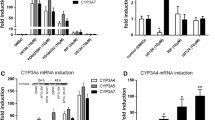Abstract.
Purpose: Docetaxel, a potent antimicrotubule agent widely used in the treatment of ovarian, breast and lung cancer, is extensively metabolized in various animal species, including humans. The metabolism of docetaxel to its primary metabolite, hydroxydocetaxel, is mediated by cytochrome P450 isozymes CYP3A2 and CYP3A4 in rats and humans, respectively. Several substrates of enzymes belonging to the CYP3A subfamily are known to induce different CYP isozymes, including CYP3A enzymes. Recently, paclitaxel, a compound structurally related to docetaxel, has been shown to significantly elevate the expression of CYP3A in rat and human hepatocytes. In this study we investigated the influence of docetaxel, employed at clinically relevant concentrations, on the level and the activity of cytochrome P450 3A in primary cultures of rat hepatocytes. Methods: Rat hepatocytes were treated with different concentrations of docetaxel, paclitaxel and other CYP3A inducers. Testosterone 6β-hydroxylase activity of intact hepatocytes was used as a marker for CYP3A. The immunoreactive CYP3A levels in the S-9 fractions were determined by Western blot analysis. Results: We observed that by day 3 of drug treatment, docetaxel at concentration in the range of 2.5–10 µM increased the CYP3A enzymatic activity and the immunoreactive CYP3A levels in a concentration-dependent manner. At the 10 µM level, docetaxel caused a twofold increase in the CYP3A activity and a threefold increase in the immunoreactive CYP3A levels. However, the docetaxel-mediated CYP3A activity and enzyme level increase were significantly lower than those mediated by paclitaxel and dexamethasone. A comparison of the testosterone 6β-hydroxylation activity in hepatocytes treated with these agents at a concentration of 5 µM each yielded the following rank order of induction capacity: dexamethasone>paclitaxel>docetaxel (15-fold, 5-fold, 2.2-fold, respectively). Conclusions: Taken together, our findings raise the possibility that docetaxel at clinically relevant concentrations increases CYP3A activity. The potential for docetaxel-mediated changes in the metabolism of other coadministered drugs and its own metabolism, in relation to that due to paclitaxel, are discussed.
Similar content being viewed by others
Author information
Authors and Affiliations
Additional information
Electronic Publication
Rights and permissions
About this article
Cite this article
Nallani, S.C., Genter, M. & Desai, P.B. Increased activity of CYP3A enzyme in primary cultures of rat hepatocytes treated with docetaxel: comparative evaluation with paclitaxel. Cancer Chemother Pharmacol 48, 115–122 (2001). https://doi.org/10.1007/s002800100283
Received:
Accepted:
Issue Date:
DOI: https://doi.org/10.1007/s002800100283




